Photo





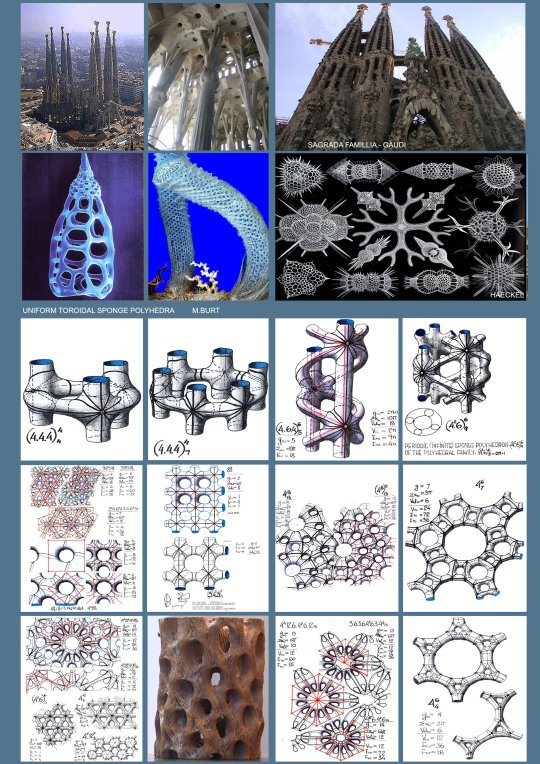


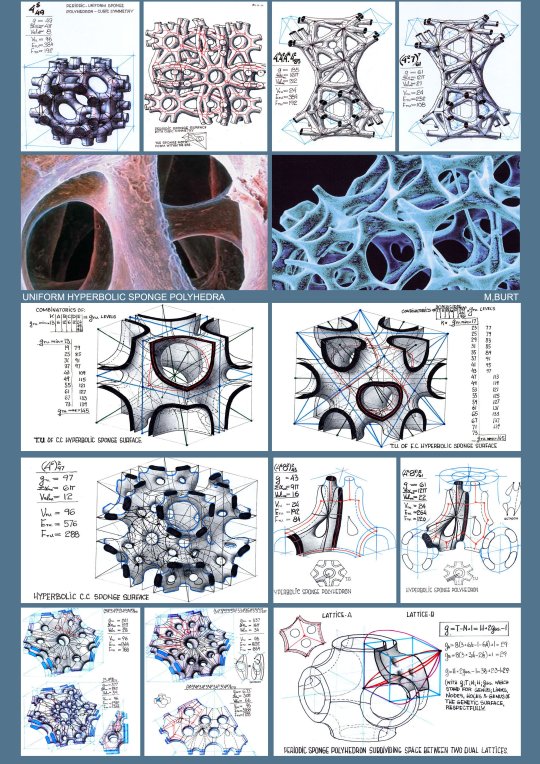
PERIODIC SPONGE SURFACES AND UNIFORM SPONGE POLYHEDRA IN NATURE AND IN THE REALM OF THE THEORETICALLY IMAGINABLE
By Michael Burt- Prof emeritus, Technion, I.I.T. Haifa Israel
The diversity of shapes and forms which meets the eye is overwhelming. They shape our environment: physical, mental, intellectual. Theirs is a dynamic milieu; time induced transformation, flowing with the change of light, with the relative movement to the eye, with physical and biological transformation and the evolutionary development of the perceiving mind.
“Our study of natural form “the essence of morphology”, is part of that wider science of form which deals with the forms assumed by nature under all aspects and conditions, and in a still wider sense, with forms which are theoretically imaginable
..(On Growth and Form D'Arcy Thompson), “Theoretically” to imply that we are dealing with causal- rational forms.
“It is the business of logic to invent purely artificial structures of elements and relations. Sometimes one of these structures is close enough to a real situation to be allowed to represent it. And then, because the logic is so tightly drawn, we gain insight into the reality which was previously withheld from us” (C. Alexander).
A particular interest should be focused on those structures which are shaped like solids or containers, with continuous two-manifold enveloping surfaces, enclosing a volume of space and thus subdividing the entire space into two complementary sub-spaces, sometimes referred to as interior and exterior, although telling which is which, is a relativistic notion. On each of these envelopes, topologically speaking, an infinite number of different maps composed of polygonal regions (faces), which are bounded by sets of edge segments and vertices, could be drawn, to represent what we call polyhedra, or polyhedral envelopes.
We come to know them by various names and notations, evolving through many historical cultures up to our present times; each representing an individual figure-polyhedron, or a family, a group, a class or a domain; convex-finite, Platonic and Archimedean polyhedra; pyramids, prisms; anti-prisms; star polyhedra; deltahedra; zonohedra; saddle polyhedra, dihedral, polydigonal, toroidal, sponge like, finite and infinite polyhedra; regular, uniform, quasi-regular, and so forth; all inscribable in our 3-dimensional space.
It is these structures and their extended derivatives which shape our physical-natural or artificial man-conceived environment and provide for our mental pictures of its architecture. The number of forms which had acquired a name or a specific notation through the ages is amounting to infinity, although the number of those which comprise our day to day formal vocabulary and design imagery is extremely (and regretfully) limited by comparison, even amongst designers and architects, whose profession, by definition, compels them to manipulate and articulate forms and space.
Here it is right to observe that name-giving is part of the creative and generative process.
The number of polyhedral forms which did not receive, as yet a proper name or a notation is also infinite. Infinite is also the number of potentially existing and possible imaginary periodic forms, not envisaged yet. Conspicuous are those relating to sponge-like labyrinthian, polyhedral, space dividing surfaces, which until quite recently were not even considered as a research topic.
The interest in these forms has been prompted by our growing awareness of their abundance in nature and their importance, not only in describing micro and macro-physical and biological phenomena, but also in coping with morphological complexity and nature of our built environment and its emerging new architecture and the order and formal character of our living spaces, on either the building or the urban scale.
Nature is saturated with sponge structures on every possible scale of physical-biological reality. The term was first adopted in biology: “Sponge: any member of the phylum Porifera, sessile aquatic animals, with single cavity in the body, with numerous pores. The fibrous skeleton of such an animal, remarkable for its power of sucking up water”. (Wordsworth dictionary).
the entire study here
© Michael Burt- Prof emeritus, Technion, I.I.T. Haifa Israel
648 notes
·
View notes
Photo
Amazing view... Almost 3 years in that city and never seen something like that...
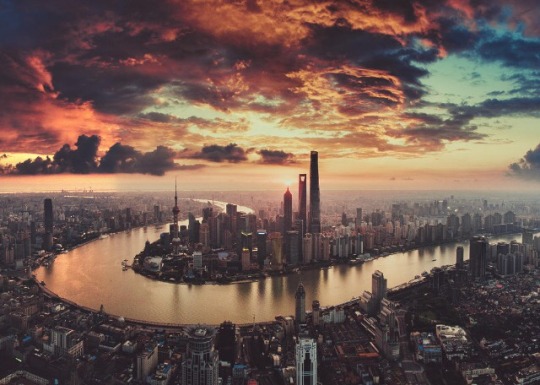
Shanghai | China
3K notes
·
View notes
Text
Gothic Design Archive

http://www.arquitectum.com/competition/1511/Gothic-Design-Archive-Barcelona-2015.html
Honourable Mention in the international competition to design Gothic Archive in Barcelona. Dream big, start small. Thank you Nataly Arevalo for your amazing help and support along, and especially at the end of the project :)
0 notes
Photo

120. UK Pavilion (EXPO Milano 2015)
UK... you did it again... Bravissimo!
3 notes
·
View notes
Photo

119. Chile Pavilion (EXPO Milano 2015)
Among many great works, this pavilion is just a REAL piece of architecture. Attractive for all the people during both: day and evening, sustainable form and practical functional program (very spacious restaurant and souvenir store under the elevated massing). Chile - you just proved that South America CAN challenge the rest of the world!
#expo#milano2015#Chile#pavilion#woodenstructure#facades#elevatedmassing#sustainable#practicalprogram
1 note
·
View note
Photo

118. USA Pavilion (EXPO Milano 2015)
“Green” pavilion by US with a very expensive, though beautiful water fountain/curtain, that actually “prints” out any kind of sentence or pattern... using water instead of ink. Most appropriate word I can find: cool!
1 note
·
View note
Photo

117. Japan Pavilion (EXPO Milano 2015)
A simple wooden artwork considering structure, a massively inspiring and complicated pattern as a result.
0 notes
Photo

116. Montenegro Pavilion (EXPO Milano 2015)
Interiors designed by my friend Miljana Radovic - a very impressive connection of the flooring with the ceiling by a mesmerizing cotton strings. They are shaped in a way, that you don’t know whether a mountain is falling from the sky, or you step on the field of clouds…
#expo#milano2015#montenegro#pavilion#interiors#cottonstrings#flooring#ceiling#mountains#clouds#mesmerizing
0 notes
Photo

115. Russia Pavilion (EXPO Milano 2015)
This was one of the simplest, yet one of the strongest concepts at the EXPO 2015. No less, no more.
0 notes
Photo

114. Vanke Pavilion (EXPO Milano 2015)
This pavilion was already my favorite even before seeing it in reality... “Dragon’s skin” interpretation like never before... plus dynamism and cladding details ensured me, that parametric design is what I find most delicious in architecture.

0 notes
Photo
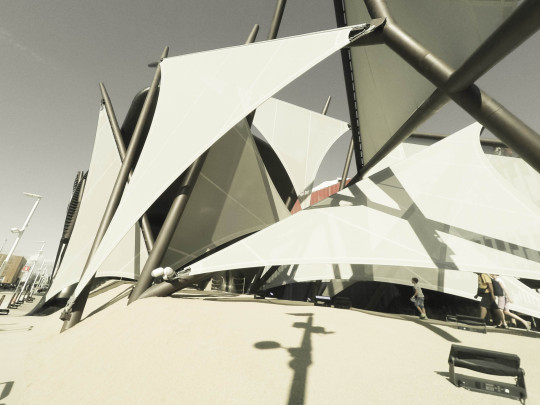
113. Kuwait Pavilion (EXPO Milano 2015)
I find this pavilion having the strongest expression of all! A game of flying surfaces connected by strong poles. It’s like a Sinbad’s ship voyaging on the ocean of dunes. Amazing!

Interiors green and spacious, full of light. Cheap, though attractive ceiling idea. Spot on!

0 notes
Photo
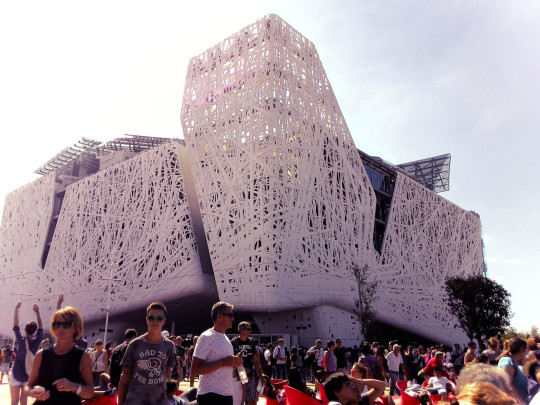
112. Italy Pavilion (EXPO Milano 2015)
This pavilion its all about the pattern, similar to the wood-wool-cement blocks.
It got me so curious how to make such pattern (at least the logic), that I solved it within a few minutes of coding in Grasshopper. Simply distribute a certain number of points on a lofted free-form surface and then split it into two groups. Then connect each set of points with one another and project the line segments on the surface - voila!

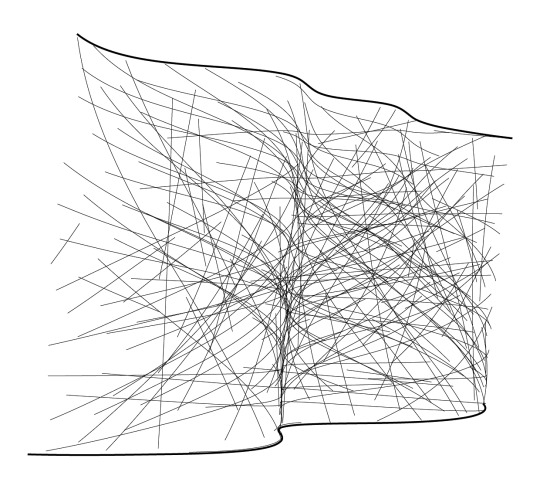


11 notes
·
View notes
Photo

111. Sculpture - main theme of EXPO Milano 2015
A Tree of Life. Isn’t it? The parametric technique used to design it is very clean and efficient, though the need of these tiny colorful decorations is taking of its glory. Comparing to sophisticated wooden, parametric forms of the Japanese Pavilion, this structure looks rather cheap and imagination-less.
1 note
·
View note
Photo

110. Slovenia Pavilion (EXPO Milano 2015)
One of my personal favorites. Strong, dynamic AND consistent forms. Nice wood covering, shading the interiors (south orientation), finally attractive landscape at the front (though there was not much space). Greenery seeking balance with this oceanic amount of pavement nearby... Bravo Slovenia!
2 notes
·
View notes
Photo

109. Poland Pavilion (EXPO Milano 2015)
The theme of all EXPO pavilions was basically... food. Designers of Polish Pavilion took it really seriously and used the wooden cases of one of the best export products - apples - as the main material. All the exteriors are covered with this repeating pattern, bringing you a simple, strong form. Dull for me, very heavy to digest... but acceptable. The best part though is the entrance with a very interesting light&shadows effect, applying its changable pattern on any surface it meets. Best was the roofing though - a garden with the sides covered by a steel sheets. The surface of these sheets was possibly selected in a way to provide reflections looking like a... oil painting... sort of...
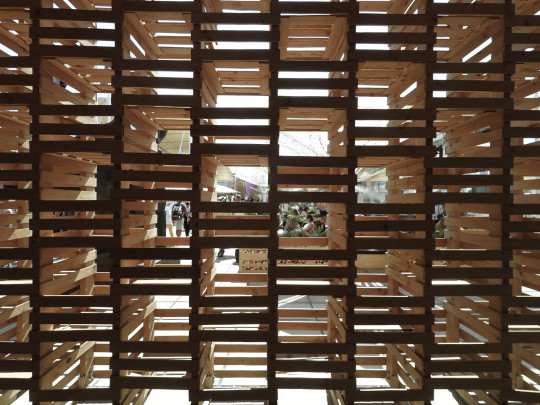
View from the restaurant/exit

The main entrance path
0 notes
Photo

108. (some) Bank Pavilion (EXPO Milano 2015)
Strong simplicity of massing and parametrism of facades left an unforgettable memory inside my mind. An example of how to design a contemporary object that could fill countless of contexts around the world...
0 notes
Photo

107. Afghanistan Pavilion (EXPO Milano 2015)
The chaos of materials, cheap effect, awkward symbolism... Yet is stands out from the horrible, horrible pavilions of its geographical neighbours! Piano pavilion if you ask me...
0 notes